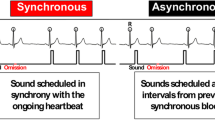Abstract
Previous research has demonstrated that auditory rhythms affect both movement and physiological functions. We hypothesized that the ecological sounds of human breathing can affect breathing more than artificial sounds of breathing, varying in tones for inspiration and expiration. To address this question, we monitored the breath duration of participants exposed to three conditions: (a) ecological sounds of breathing, (b) artificial sounds of breathing having equal temporal features as the ecological sounds, (c) no sounds (control). We found that participants’ breath duration variability was reduced in the ecological sound condition, more than in the artificial sound condition. We suggest that ecological sounds captured the timing of breathing better than artificial sounds, guiding as a consequence participants’ breathing. We interpreted our results according to the Theory of Event Coding, providing further support to its validity, and suggesting its possible extension in the domain of physiological functions which are both consciously and unconsciously controlled.


Similar content being viewed by others
References
Agostini, T., Righi, G., Galmonte, A., & Bruno, P. (2004). The relevance of auditory information in optimizing hammer throwers performance. In P. B. Pascolo (Ed.), Biomechanics and sports (pp. 67–74). Vienna: Springer.
Chen, J. L., Penhune, V. B., & Zatorre, R. J. (2008). Listening to musical rhythms recruits motor regions of the brain. Cerebral Cortex, 18, 2844–2854.
Effenberg, A. O. (2005). Movement sonification: effects on perception and action. IEEE Multimedia, 12, 53–59.
Ekman, I., Kjellström, B., Falk, K., Norman, J., & Swedberg, K. (2011). Impact of device-guided slow breathing on symptoms of chronic heart failure: a randomized controlled feasibility study. European Journal of Heart Failure, 13, 1000–1005.
Elliott, W. J., & Izzo, J. L, Jr. (2006). Device-guided breathing to lower blood pressure: case report and clinical overview. Medscape General Medicine, 8(3), 23.
Gavish, B. (2010). Device-guided breathing in the home setting: technology, performance and clinical outcomes. Biological Psychology, 84, 150–156.
Hommel, B., Müsseler, J., Aschersleben, G., & Prinz, W. (2001). The theory of event coding (TEC): a framework for perception and action planning. Behavioral and Brain Sciences, 24, 849–878.
Kohler, E., Keysers, C., Umiltà, M. A., Fogassi, L., Gallese, V., et al. (2002). Hearing sounds, understanding actions: action representation in mirror neurons. Science, 297, 846–848.
Lahav, A., Katz, T., Chess, R., & Saltzman, E. (2013). Improved motor sequence retention by motionless listening. Psychological Research, 77, 310–319.
Mahtani, K. R., Nunan, D., & Heneghan, C. J. (2012). Device-guided breathing exercises in the control of human blood pressure: systematic review and meta-analysis. Journal of Hypertension, 30, 852–860.
Meuret, A. E., Wilhelm, F. H., & Roth, W. T. (2001). Respiratory biofeedback-assisted therapy in panic disorder. Behavior Modification, 25(4), 584–605.
Murgia, M., Forzini, F., & Agostini, T. (2014). Migliorare le prestazioni sportive. Superare il doping con la psicologia sperimentale applicata al movimento. Milan: Franco Angeli.
Murgia, M., Hohmann, T., Galmonte, A., Raab, M., & Agostini, T. (2012). Recognising one’s own motor actions through sound: the role of temporal factors. Perception, 41, 976–987.
Nombela, C., Hughes, L. E., Owen, A. M., & Grahn, J. A. (2013). Into the groove: can rhythm influence Parkinson’s disease? Neuroscience and Biobehavioral Reviews, 37, 2564–2570.
Pelton, T. A., Johannsen, L., Chen, H., & Wing, A. M. (2010). Hemiparetic stepping to the beat: asymmetric response to metronome phase shift during treadmill gait. Neurorehabilitation and Neural Repair, 24, 428–434.
Ritz, T., Meuret, A. E., Bhaskara, L., & Petersen, S. (2013). Respiratory muscle tension as symptom generator in individuals with high anxiety sensitivity. Psychosomatic Medicine, 75, 187–195.
Rizzolatti, G., & Craighero, L. (2004). The mirror-neuron system. Annual Review of Neuroscience, 27, 169–192.
Rizzolatti, G., Fadiga, L., Gallese, V., & Fogassi, L. (1996). Premotor cortex and the recognition of motor actions. Cognitive Brain Research, 3, 131–141.
Schmitz, G., Mohammadi, B., Hammer, A., Heldmann, M., Samii, A., et al. (2013). Observation of sonified movements engages a basal ganglia frontocortical network. BMC Neuroscience, 14, 32.
Stupacher, J., Hove, M. J., Novembre, G., Schütz-Bosbach, S., & Keller, P. E. (2013). Musical groove modulates motor cortex excitability: a TMS investigation. Brain and Cognition, 82, 127–136.
Thaut, M. H., & Abiru, M. (2010). Rhythmic auditory stimulation in rehabilitation of movement disorders: a review of current research. Music Perception, 27, 263–269.
Zmigrod, S., & Hommel, B. (2009). Auditory event files: integrating auditory perception and action planning. Attention, Perception, and Psychophysics, 71, 352–362.
Acknowledgments
We would like to thank Bernhard Hommel and two anonymous reviewers for their valuable suggestions.
Ethical standards
The present study was approved by the Research Ethics Committee of the University of Trieste in compliance with national legislation, the Ethical Code of the Italian Association of Psychology, and the ethical standards laid down in the 1964 Declaration of Helsinki and its later amendments.
Author information
Authors and Affiliations
Corresponding author
Rights and permissions
About this article
Cite this article
Murgia, M., Santoro, I., Tamburini, G. et al. Ecological sounds affect breath duration more than artificial sounds. Psychological Research 80, 76–81 (2016). https://doi.org/10.1007/s00426-015-0647-z
Received:
Accepted:
Published:
Issue Date:
DOI: https://doi.org/10.1007/s00426-015-0647-z




